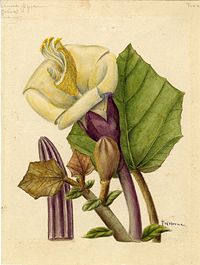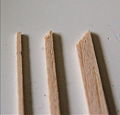Balsa
| Balsa | ||||||||||||||
|---|---|---|---|---|---|---|---|---|---|---|---|---|---|---|
 Painting by Frances W. Horne from the Flora Borinqueña
| ||||||||||||||
| Scientific classification | ||||||||||||||
| ||||||||||||||
| Ochroma pyramidale (Cav. ex Lam.) Urb. |
Balsa (Ochroma pyramidale, synonym O. lagopus) is a large, fast-growing tree that can grow up to 30 m tall, native to tropical South America north to southern Mexico. It is evergreen, or dry-season deciduous if the dry season is long, with large (30–50 cm) weakly palmately lobed leaves. The name balsa derives from Spanish for a raft.
The timber is very soft and light with a coarse open grain. The density of dry balsa wood ranges from 100–200 kg/m³, with a typical density of about 140 kg/m³ (about one third the density of other kinds of hard wood). This makes it a very popular material for model building and buoyancy materials (lifebelts, etc.), and was famously used by Thor Heyerdahl in his raft Kon-Tiki. It is also a very popular material to use when making wooden crankbaits for fishing, as it is low density but high in strength. Balsa wood is used to make very light, stiff structures in model bridge tests and for the construction of light wooden aeroplanes, most famously the World War II de Havilland Mosquito. It also is used in the floorpan of the Chevrolet Corvette Z06 sandwiched between two sheets of carbon fibre. In table tennis blades, a balsa layer is typically sandwiched between two pieces of thin plywood.Balsa wood is also used for making high-quality balsa surfboards.[1]
Despite being very soft, balsa is classified as a hardwood, the softest commercial hardwood.
ReferencesISBN links support NWE through referral fees
- Technical Description, History, Facts, Specs Retrieved October 12, 2007.
- Species description Retrieved October 12, 2007.
- Germplasm Resources Information Network: Ochroma pyramidale Retrieved October 12, 2007.
- Photo of foliage and flower Retrieved October 12, 2007.
- Kon-Tiki museum website Retrieved October 12, 2007.
- Balsa rafting in Ecuador Retrieved October 12, 2007.
Credits
New World Encyclopedia writers and editors rewrote and completed the Wikipedia article in accordance with New World Encyclopedia standards. This article abides by terms of the Creative Commons CC-by-sa 3.0 License (CC-by-sa), which may be used and disseminated with proper attribution. Credit is due under the terms of this license that can reference both the New World Encyclopedia contributors and the selfless volunteer contributors of the Wikimedia Foundation. To cite this article click here for a list of acceptable citing formats.The history of earlier contributions by wikipedians is accessible to researchers here:
The history of this article since it was imported to New World Encyclopedia:
Note: Some restrictions may apply to use of individual images which are separately licensed.

